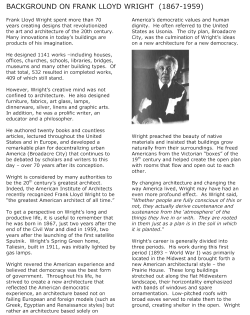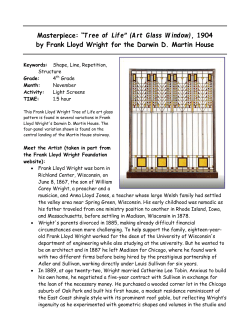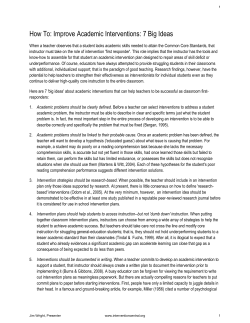
Some Sparse Optimization Problems and How to Solve Them Stephen Wright May 2013
Some Sparse Optimization Problems
and How to Solve Them
Stephen Wright
University of Wisconsin-Madison
May 2013
Wright (UW-Madison)
Edinburgh Math Colloquium
May 2013
1 / 57
Two Topics
I. Identification of low-dimension subspace from incomplete data. (+
Laura Balzano — Michigan)
II. Packing ellipsoids with overlap. (+ Caroline Uhler — IST Austria)
Wright (UW-Madison)
Edinburgh Math Colloquium
May 2013
2 / 57
I. Identifying Subspaces from Partial Observations
Often we observe a certain phenomenon on a high-dimensional ambient
space, but the phenomenon lies on a low-dimension subspace. Moreover,
our observations may not be complete: missing data
Can we recover the subspace of interest?
Matrix completion, e.g. Netflix. Observe partial rows of an m × n
matrix; each row lies (roughly) in a low-d subspace of Rn .
Background/foreground separation in video data.
Mining of spatal sensor data (traffic, temperature) with high
correlation between locations.
Linear system identification in control, with streaming data?
Structure from Motion: Observe a 3-d object from different camera
angles, noting the location of reference points. Some points are
occluded from some angles.
Wright (UW-Madison)
Edinburgh Math Colloquium
May 2013
3 / 57
Structure from Motion
(Kennedy, Balzano, Taylor, Wright, 2013)
Wright (UW-Madison)
Edinburgh Math Colloquium
May 2013
4 / 57
Subspace Identification: Formalities
Seek subspace S ⊂ Rn of known dimension d n.
Know certain components Ωt ⊂ {1, 2, . . . , n} of vectors vt ∈ S,
t = 1, 2, . . . — the subvector [vt ]Ωt .
Assume that S is incoherent w.r.t. the coordinate directions.
Assume that
¯ t , where range(U)
¯ = S, and U
¯ is n × d orthonormal, and the
vt = Us
d
components of st ∈ R are i.i.d. normal with mean 0.
Sample set Ωt is independent for each t with |Ωt | ≥ q, for some q
between d and n.
Observation subvectors [vt ]Ωt contain no noise.
Full-data case Ωt ≡ {1, 2, . . . , n} gives the solution after d steps — but
the algorithm still yields an interesting result.
Wright (UW-Madison)
Edinburgh Math Colloquium
May 2013
5 / 57
Sampled Data: An Online / Incremental Algorithm
Balzano (2012)
GROUSE (Grassmannian Rank-One Update Subspace Estimation).
Process the vt sequentially.
¯
Maintain an estimate Ut (orthonormal n × d) of subspace basis U.
Simple update formula Ut → Ut+1 , based on (vt )Ωt .
Note:
Setup is similar to incremental and stochastic gradient methods.
Rank-one update formula for Ut is akin to updates in quasi-Newton
Hessian and Jacobian approximations in optimization.
Projection, so that all iterates Ut are n × d orthonormal.
Wright (UW-Madison)
Edinburgh Math Colloquium
May 2013
6 / 57
One GROUSE Step
¯ t:
Given current estimate Ut and partial data vector [vt ]Ωt , where vt = Us
wt := arg min k[Ut w − vt ]Ωt k22 ;
w
pt := Ut wt ;
[rt ]Ωt := [vt − Ut wt ]Ωt ;
[rt ]Ωct := 0;
σt := krt kkpt k;
Choose ηt > 0;
Ut+1
T
pt
rt
wt
:= Ut + (cos σt ηt − 1)
+ sin σt ηt
;
kpt k
krt k kwt k
We focus on the (locally acceptable) choice
ηt =
1
krt k
arcsin
,
σt
kpt k
Wright (UW-Madison)
which yields σt ηt = arcsin
Edinburgh Math Colloquium
krt k
krt k
≈
.
kpt k
kpt k
May 2013
7 / 57
GROUSE Comments
With the particular step above, and assuming krt k kpt k, have
[Ut+1 wt ]Ωt ≈ [pt + rt ]Ωt = [vt ]Ωt ,
[Ut+1 wt ]Ωct ≈ [pt + rt ]Ωct = [Ut wt ]Ωct .
Thus
On sample set Ωt , Ut+1 wt matches obervations in vt ;
On other elements, the components of Ut+1 wt and Ut wt are similar.
Ut+1 z = Ut z for any z with wtT z = 0.
The GROUSE update is essentially a projection of a step along the search
direction rt wtT , which is a negative gradient of the inconsistency measure
E(Ut ) := min k[Ut ]Ωt wt − [vt ]Ωt k22 .
wt
The GROUSE update makes the minimal adjustment required to
match the latest observations, while retaining a certain desired
structure — orthonormality, in this case.
Wright (UW-Madison)
Edinburgh Math Colloquium
May 2013
8 / 57
GROUSE Local Convergence Questions
How to measure discrepancy between current estimate R(Ut ) and S?
Convergence behavior is obviously random, but what can we say
about expected rate? Linear? If so, how fast?
How many components q of vt are needed at each step?
For the first question, can use angles between subspaces φt,i ,
i = 1, 2, . . . , d.
¯
cos φt,i = σi (UtT U),
where σi (·) denotes the ith singular value. Define
t :=
d
X
i=1
sin2 φt,i = d −
d
X
¯ 2 = d − kUtT Uk
¯ 2.
σi (UtT U)
F
i=1
We seek a bound for E [t+1 |t ], where the expectation is taken over the
¯ t.
random vector st for which vt = Us
Wright (UW-Madison)
Edinburgh Math Colloquium
May 2013
9 / 57
Full-Data Case (q = n)
Full-data case vastly simpler to analyze than the general case. Define
θt := arccos(kpt k/kvt k) is the angle between range(Ut ) and S that is
revealed by the update vector vt ;
¯ d × d. We have t = d − kAt k2 .
Define At := UtT U,
F
Lemma
t − t+1
sin(σt ηt ) sin(2θt − σt ηt )
=
sin2 θt
s T AT At AT At st
1 − t Tt T t
st At At st
,
The right-hand side is nonnegative for σt ηt ∈ (0, 2θt ), and zero if
vt ∈ R(Ut ) = St or vt ⊥ St .
The favored choice of ηt (defined above) yields σt ηt = θt , thus:
t − t+1 = 1 −
Wright (UW-Madison)
T
stT AT
t At At At st
.
stT AT
t At st
Edinburgh Math Colloquium
May 2013
10 / 57
Full-Data Result
Need to calculate an expected value of the bound, over the random vector
st . Needs some work, but we end up with:
Theorem
Suppose that t ≤ ¯ for some ¯ ∈ (0, 1/3). Then
1 − 3¯
1
E [t+1 | t ] ≤ 1 −
t .
1 − ¯ d
Linear convergence rate is asymptotically 1 − 1/d.
For d = 1, get near-convergence in one step (thankfully!)
Generally, in d steps (which is number of steps to get the exact
solution using SVD), improvement factor is
(1 − 1/d)d <
1
.
e
Computations confirm: Slow early, then linear with rate (1 − 1/d).
Wright (UW-Madison)
Edinburgh Math Colloquium
May 2013
11 / 57
t vs expected (1 − 1/d) rate (for various d)
Wright (UW-Madison)
Edinburgh Math Colloquium
May 2013
12 / 57
General Case: Preliminaries
Assume a regime in which t is small.
Define coherence of S (w.r.t. coordinate directions) by
µ
¯ :=
n
d
max
i=1,2,...,n
kPS ei k22 .
It’s in range [1, n/d], nearer the bottom if “incoherent.”
Add a safeguard to GROUSE: Take the step only if
|Ωt |
|Ωt |
T
σi ([Ut ]Ωt [Ut ]Ωt ) ∈ .5
, 1.5
, i = 1, 2, . . . , d,
n
n
i.e. the sample is big enough to capture accurately the expression of vt in
terms of the columns of Ut . Can show that this will happen w.p. ≥ .9 if
|Ωt | ≥ q ≥ C1 (log n)2 d µ
¯ log(20d),
Wright (UW-Madison)
Edinburgh Math Colloquium
C1 ≥
64
.
3
May 2013
13 / 57
The Result
Require conditions on q and the fudge factor C1 :
q ≥ C1 (log n)2 d µ
¯ log(20d),
C1 ≥
64
;
3
Also need C1 large enough that the coherence in the residual between vt
and current subspace estimate Ut satisfies a certain (reasonable) bound
¯ for some δ¯ ∈ (0, .6). Then for
w.p. 1 − δ,
3
¯2 q ,
t ≤ (8 × 10−6 )(.6 − δ)
n3 d 2
1 d
t ≤
µ
¯,
16 n
we have
¯ q t .
E [t+1 | t ] ≤ 1 − (.16)(.6 − δ)
nd
Wright (UW-Madison)
Edinburgh Math Colloquium
May 2013
14 / 57
The Result: Comments and Steps
The decrease constant it not too far from that observed in practice; we see
a factor of about
q
1−X
nd
where X is not too much less than 1.
The threshold condition on t is quite pessimistic, however. Linear
convergence behavior is seen at much higher values of t .
18 pages (SIAM format) of highly technical analysis, involving:
High-probability estimates of residual krt k;
Noncommutative Bernstein inequality;
Deterministic bound on t+1 in terms of t and krt k2 /kpt k2 ;
Incoherence assumption on the error identified by most samples;
An expectation argument like the ones used in the full-data case.
Wright (UW-Madison)
Edinburgh Math Colloquium
May 2013
15 / 57
Computations for GROUSE with Sampling
Choose U0 so that 0 is between 1 and 4.
Stop when t ≤ 10−6 .
Calculate average convergence rate: value X such that
q N
.
N ≈ 0 1 − X
nd
We find that X is not too much less than 1!
n
500
500
500
5000
Wright (UW-Madison)
d
10
10
20
10
q
50
25
100
40
X
.79
.57
.82
.72
Edinburgh Math Colloquium
May 2013
16 / 57
Computations: Straight Downhill
Wright (UW-Madison)
Edinburgh Math Colloquium
May 2013
17 / 57
iSVD (Incremental SVD)
GROUSE is closely related to the following incremental SVD approach.
Given Ut and [vt ]Ωt :
Compute wt as in GROUSE:
wt := arg min k[Ut w − vt ]Ωt k22 .
w
Use wt to impute the unknown elements (vt )ΩCt , and fill out vt with
these estimates:
[vt ]Ωt
.
v˜t :=
[Ut ]Ωct wt
Append v˜t to Ut and take the SVD of the resulting n × (d + 1)
matrix [Ut : v˜t ];
Define Ut+1 to be the leading d singular vectors. (Discard the
singular vector that corresponds to the smallest singular value of the
augmented matrix.)
Wright (UW-Madison)
Edinburgh Math Colloquium
May 2013
18 / 57
Relating iSVD and GROUSE
Theorem
Suppose we have the same Ut and [vt ]Ωt at the t-th iterations of iSVD
and GROUSE. Then there exists ηt > 0 in GROUSE such that the next
iterates Ut+1 of both algorithms are identical, to within an orthogonal
transformation.
The choice of ηt (details below) is not the same as the “optimal” choice in
GROUSE, but it works fairly well in practice.
q
1
2
2
2
2
2
2
(kwt k + krt k + 1) + (kwt k + krt k + 1) − 4krt k
λ=
2
krt k2 kwt k2
β=
krt k2 kwt k2 + (λ − krt k2 )2
1
ηt =
arcsin β.
σt
Wright (UW-Madison)
Edinburgh Math Colloquium
May 2013
19 / 57
II. Packing Circles and Ellipses (and Chromosomes)
Classical Results in Circle Packing
Packing Circles with Minimal Overlap
Formulation
Algorithm
Results
Packing Ellipsoids with Minimal Overlap
Formulation
Algorithm
Results
Chromosome Arrangement.
Background
Investigate: Can geometry explain arrangements?
Wright (UW-Madison)
Edinburgh Math Colloquium
May 2013
20 / 57
Circle Packing: Classical Questions
1. “Pack identical circles as densely as possible in the infinite plane.”
2. “Pack identical spheres (3d and higher) as densely as possible in
infinite space.”
3. “Pack N identical circles in enclosing circle of minimal radius.”
√
For Q.1, the hexagonal packing has optimal density, which is π/ 12.
(Thue, 1910; Toth, 1940). Each circle has six neighbors.
Wright (UW-Madison)
Edinburgh Math Colloquium
May 2013
21 / 57
Sphere Packing
For Q.2, there are “close-packed structures” with dense layers, each layer
arranged “hexagonally.”
Each sphere has 12 neighbors. All achieve
√
densities of π/ 18. Face-centered cubic (FCC) is one such structure.
Wright (UW-Madison)
Edinburgh Math Colloquium
May 2013
22 / 57
Gauss (1831) proved
√ that the structures described above have the
highest density (π/ 18) among regular packings.
Kepler (1611) conjectured that this density is the highest achievable
among all packings, regular or irregular.
Hales (1998, 2005) following Toth (1953) proved Kepler’s conjecture.
Hales’ proof required computational solution of 100,000 LPs.
Requires checking of many irregular packings, some of which have higher
local density than the best regular packings, but which cannot be extended
infinitely.
Hales is working on a version of the proof that can be formally verified
(Flyspeck project).
Wright (UW-Madison)
Edinburgh Math Colloquium
May 2013
23 / 57
Q.3: Circle Packings in a Circle
Consider 91 identical circles arranged hexagonally:
Can we rearrange these to fit them in a smaller circle, without overlap?
R. L. Graham, B. D. Lubachevsky et al, Discrete Mathematics 181 (1998), pp. 139–154.
Wright (UW-Madison)
Edinburgh Math Colloquium
May 2013
24 / 57
Curved Hexagonal Packings
YES! A slight twisting of the hexagonal arrangement reduces by about 5%
the radius of the enclosing circle.
Google “circle packing Magdeburg” for best known packings up to about
N = 1100. (Only N = 1, 2, . . . , 13 and N = 19 are proved optimal.)
Wright (UW-Madison)
Edinburgh Math Colloquium
May 2013
25 / 57
Packing Spheres with Overlap
(Pose and solve in Rn ; not restricted to n = 2 or n = 3.)
Given N spheres of prescribed radius ri , i = 1, 2, . . . , N, and a
convex set Ω, choose centers ci ∈ Rn so that the cirles lie within
Ω and some measure of total overlap is minimized.
Measure overlap between two spheres by diameter of largest sphere
inscribed in their intersection: ri + rj − kci − cj k2 .
Wright (UW-Madison)
Edinburgh Math Colloquium
May 2013
26 / 57
Formulation
Given convex enclosing set Ω, can define a convex set Ωi of allowable
values for the center ci of circle i.
Capture overlap between circles i and j by ξij :
ξij := max(0, (ri + rj ) − kci − cj k2 ),
ξ := (ξij )1≤i<j≤N .
Aggregate the pairwise overlaps ξij into a single objective H (for example,
sum of squares or maxi,j ξij ).
Optimization formulation, with unknowns ci , i = 1, 2, . . . , N and ξ:
min
c,ξ
subject to
H(ξ)
(ri + rj ) − kci − cj k2 ≤ ξij
for 1 ≤ i < j ≤ N
0 ≤ ξ,
c i ∈ Ωi ,
Wright (UW-Madison)
for i = 1, 2, . . . , N.
Edinburgh Math Colloquium
May 2013
27 / 57
Optimality Conditions
Highly nonconvex problem. Conditions for a Clarke stationary point are
that there exist λij ∈ R such that
0 ≤ gij − λij ⊥ ξij ≥ 0 for some gij ∈ ∂ξij H(ξ),
N
X
λij wij −
j=i+1
i−1
X
λji wji ∈ NΩi (ci ),
1 ≤ i < j ≤ N,
i = 1, 2, . . . , N,
j=1
0 ≤ ξij + kci − cj k − (ri + rj ) ⊥ λij ≥ 0,
1 ≤ i < j ≤ N,
ci − c j
when ci 6= cj , 1 ≤ i < j ≤ N
where kwij k2 ≤ 1, with wij =
kci − cj k2
Here
NΩi (ci ) is the normal cone to Ωi at ci ;
∂ denotes subdifferential.
Wright (UW-Madison)
Edinburgh Math Colloquium
May 2013
28 / 57
Algorithm: Key Subproblem
Linearize the constraint defining ξij about the current point c − , to define
the subproblem to be solved at each iteration:
¯
P(c − ) := min H(ξ)
c,ξ¯
subject to
(ri + rj ) − zijT (ci − cj ) ≤ ξ¯ij ,
¯
0 ≤ ξ,
for 1 ≤ i < j ≤ N,
ci ∈ Ωi , for i = 1, . . . , N,
(
(ci− − cj− )T /kci− − cj− k
where zij :=
0
when ci− 6= cj−
otherwise.
Use the original objective H — no need to approximate since it’s simple.
Depending on the form of H and Ωi , P(c − ) could be a linear program,
quadratic program, or more general conic program.
Wright (UW-Madison)
Edinburgh Math Colloquium
May 2013
29 / 57
Algorithm
Given ri > 0 and constraint sets Ωi , i = 1, 2, . . . , N;
Choose c 0 ∈ Ω1 × Ω2 × · · · × ΩN ;
for k = 0, 1, 2, . . . do
Generate zij for 1 ≤ i < j ≤ N;
Solve subproblem P(c k ) to obtain (c k+1 , ξ¯k+1 );
if H(ξ¯k+1 ) = H(ξ k ) then
stop and return c k ;
end if
Set ξijk+1 = max(0, (ri + rj ) − kcik+1 − cjk+1 k) for 1 ≤ i < j ≤ N;
end for
Wright (UW-Madison)
Edinburgh Math Colloquium
May 2013
30 / 57
Convergence
If (c k , ξ k ) solves the subproblem P(c k ) (i.e. algorithm doesn’t move),
then it is stationary for the main problem.
If the current (c k , ξ k ) is stationary for the main problem, with
cik 6= cjk for i 6= j, then it also solves the subproblem P(c k ).
If (c k , ξ k ) is not stationary for the main problem, then the
subproblem predicts a strict reduction in objective: H(ξ¯k+1 ) < H(ξ k ).
Objective H improves even more than forecast: H(ξ k+1 ) < H(ξ¯k+1 ).
Linearization overestimates the true overlap. Thus, no need for trust
region or line search.
Result: All accumulation points cˆ of the sequence {c k } are either
stationary or degenerate (i.e. cˆi = cˆj for i 6= j).
There are typically many local minima, or families of minima. Computed
solution depends on starting point.
Wright (UW-Madison)
Edinburgh Math Colloquium
May 2013
31 / 57
Results: Emergence of Hexagons
Packing 100 circles into a square with min-max overlap.
Many different local minima obtained. The square grid is one such, but
there are better solutions in which hexagonal structure emerges in large
parts of the domain.
(Hexagonal packing overlap is ≈ .1149.)
Wright (UW-Madison)
Edinburgh Math Colloquium
May 2013
32 / 57
Packing Ellipsoids: M&Ms
Wright (UW-Madison)
Edinburgh Math Colloquium
May 2013
33 / 57
Packing 3D Ellipsoids: Results (from Science, 2004)
√
Optimal ordered packing for spheres has density π/ 18 ≈ .74.
“Random” spherical packings have density ≈ .64, with each sphere
touching about 6 of its neighbors (on average).
Densities of random packings increase when spheres become
ellipsoids. More contacts with neighbors are required for a “jammed”
configuration.
Among prolate and oblate ellipsoids, best packing is attained by
ellipsoids with aspect ratio similar to M&Ms. Density ≈ .685 with
about 10 contacts per ellipsoid.
Donev et al verified by measurements with actual M&Ms and a
molecular-dynamics simulation. Other authors did experiments on
sphere packing with ball bearings.
Our algorithm applied to uniform spheres gave packings with an average of
11.5 neighbors per sphere — close to the FCC count of 12, much higher
than random packing count of 6.
Wright (UW-Madison)
Edinburgh Math Colloquium
May 2013
34 / 57
Ellipsoids: S-Lemma
Given two ellipses:
E = {x ∈ R3 | (x − c)T S −2 (x − c) ≤ 1} = {c + Su | kuk2 ≤ 1},
¯ | kuk2 ≤ 1}.
E¯ = {x ∈ R3 | (x − c¯)T S¯ −2 (x − c¯) ≤ 1} = {¯
c + Su
The containment condition E¯ ⊂ E can be represented as the following
¯ c, and S 2 : There exists
linear matrix inequality (LMI) in parameters c¯, S,
λ ∈ R such that
−λI
0
S¯
0
λ − 1 (¯
c − c)T 0.
S¯
c¯ − c
−S 2
For two ellipsoids Ei and Ej , with 1 ≤ i < j ≤ N, denote their parameters
by (ci , Si ) and (cj , Sj ).
It’s also useful to define Σi := Si2 and Σj := Sj2 .
Wright (UW-Madison)
Edinburgh Math Colloquium
May 2013
35 / 57
Ellipsoid Overlaps
Measure the overlap between two ellipsoids as the maximal sum of
principal axes of any ellipsoid inscribed in the intersection.
Wright (UW-Madison)
Edinburgh Math Colloquium
May 2013
36 / 57
Ellipsoids: Measuring Overlap
Use the S-Lemma containment result above to formulate a subproblem to
ˆ i , cj , Σi , Σj )
measure overlap, denoted by O(c
max
Sij 0,cij ,λij1 ,λij2
subject to
Wright (UW-Madison)
trace(Sij )
−λij1 I
0
Sij
−λij2 I
0
Sij
0
Sij
λij1 − 1 (cij − ci )T 0,
cij − ci
−Σi
0
Sij
λij2 − 1 (cij − cj )T 0.
cij − cj
−Σj
Edinburgh Math Colloquium
May 2013
37 / 57
Dual Formulation of Overlap
Introduce matrices Mij1 and Mij2 defined by
Rij1 rij1 Pij1
Rij2 rij2 Pij2
T
T
T
T
pij1 qij1
pij2 qij2
Mij1 := rij1
,
Mij2 := rij2
,
Pij1 qij1 Qij1
Pij2 qij2 Qij2
Now can write the dual explicitly as follows:
min
Mij1 0,Mij2 0,Tij 0
T
T
pij1 + pij2 + 2qij1
ci + 2qij2
cj
+ hQij1 , Σi i + hQij2 , Σj i
subject to
0 = I + Tij − 2Pij1 − 2Pij2
0 = trace(Rij1 ) − pij1
0 = trace(Rij2 ) − pij2
0 = qij1 + qij2 .
Wright (UW-Madison)
Edinburgh Math Colloquium
May 2013
38 / 57
Overlap Problem: Sensitivity of Objective
Since the dual always has a strictly feasible point, strong duality
holds: the optimal primal and dual objectives are the same.
ˆ i , cj , Σi , Σj ), parameters defining the
In the dual formulation of O(c
two ellipses ci , cj , Σi , Σj enter only into the objective, not the
constraints.
ˆ i , cj , Σi , Σj ) to the parameters can be obtained from
Sensitivity of O(c
the dual optimal values, in particular qij1 , qij2 , Qij1 , and Qij2 .
Hence, when the dual solution exists, we can use it to construct a
linearized model of the overlap, as a function of the positions and
orientations of Ei and Ej .
Wright (UW-Madison)
Edinburgh Math Colloquium
May 2013
39 / 57
Packing Ellipses in an Ellipse
Using the overlap notation, formulation the problem of packing ellipses in
an ellipse with min-max overlap as follows:
min
ξ
ξ,(ci ,Si ,Σi ),i=1,2,...,N
subject to
ˆ i , cj , Σi , Σj ),
ξ ≥ O(c
1 ≤ i < j ≤ N,
Ei ⊂ E,
i = 1, 2, . . . , N,
Σi =
Si2 ,
i = 1, 2, . . . , N,
semi-axes of Ei have lengths ri1 , ri2 , ri3 , i = 1, 2, . . . , N.
The scalar ξ captures the maximum overlap;
Ei , i = 1, 2, . . . , N denote the ellipses with specified axes (ri1 , ri2 , ri3 ),
E denotes the circumscribing ellipse.
Wright (UW-Madison)
Edinburgh Math Colloquium
May 2013
40 / 57
Nonconvexity
The problem is highly nonconvex.
ˆ i , cj , Σi , Σj ) is a nonconvex function of its arguments - this
Each O(c
is intrinsic.
Constraint Σi = Si2 is nonconvex. Can easily replace it by the
following convex pair of constraints:
Σi Si
0,
Si 0.
Si I
Constraints on the eigenvalues of Si are nonconvex. We replace these
by convex relaxations:
Si − ri1 I 0,
Si − ri3 I 0,
trace(Si ) = ri1 + ri2 + ri3 .
We formulate the inclusion condition Ei ⊂ E in a convex fashion, using the
S-Lemma, as above.
Wright (UW-Madison)
Edinburgh Math Colloquium
May 2013
41 / 57
Successive Linearization Strategy
ELL: The min-max-overlap problem, after relaxations.
Propose a trust-region bilevel successive linearization strategy for finding
local solutions of ELL. Each iteration solves one “big” top-level conic
program, and many small conic programs corresponding to the pairwise
dual overlaps.
Solve the dual overlaps for each pair of nearby ellipses (i, j);
ˆ i , cj , Σi , Σj ) for the pairs
Use dual optimal values to linearize ξ ≥ O(c
(i, j) with significant overlap;
Incorporate the other formulation elements described above, to get a
conic programming subproblem;
Add a trust-region constraint on the steps;
If the step gives a sufficient improvement in the max overlap, accept
it. Otherwise, shrink the trust-region radius and try again.
Wright (UW-Madison)
Edinburgh Math Colloquium
May 2013
42 / 57
Trust-Region Subproblem
min
ξ
ξ,(λi ,ci ,Si ,Σi ),i=1,2,...,N
subject to
T
T
ξ ≥ pij1 + pij2 + 2qij1
ci + 2qij2
cj
+ hQij1 , Σi i + hQij2 , Σj i,
for (i, j) ∈ I,
−λi I
0
Si
0
λi − 1 (ci − c)T 0, i = 1, 2, . . . , N,
Si
ci − c
−Σ
Σi Si
0,
i = 1, 2, . . . , N,
Si I
Si − ri1 I 0,
Wright (UW-Madison)
Si − ri3 I 0,
i = 1, 2, . . . , N,
trace(Si ) = ri1 + ri2 + ri3 ,
i = 1, 2, . . . , N,
kci − ci− k22 ≤ ∆2c ,
kSi − Si− k ≤ ∆S ,
|λi − λ−
i | ≤ ∆λ ,
i = 1, 2, . . . , N,
Edinburgh Math Colloquium
i = 1, 2, . . . , N,
i = 1, 2, . . . , N.
May 2013
43 / 57
Framework for Analysis
We simplify and generalize the problem for purposes of convergence
analysis. Each pairwise overlap problem is stated as an
objective-parametrized SDP:
P(l, C ) :
tl∗ (C ) := min hC , Ml i
Ml
s.t. hAl,i , Ml i = bl,i , i = 1, 2, . . . , pl , Ml 0,
which is assumed to satisfy a Slater condition. Each index l represents a
single pair of ellipsoids.
The top-level problem is
min t ∗ (C ) :=
C ∈Ω
max
l=1,2,...,m
tl∗ (C ),
where Ω is a closed convex set. (Actually, Ω is the intersection of a closed
convex set with nonempty interior and a hyperplane.)
Wright (UW-Madison)
Edinburgh Math Colloquium
May 2013
44 / 57
Convergence
Convergence analysis uses
both convex and nonconvex analysis, particularly Clarke’s (1983)
concepts of generalized gradients and stationary;
SDP duality and optimality conditions;
trust-region machinery.
Result: Except for finitely-terminating degenerate cases, convergent
subsequences of the algorithm are Clarke-stationary or no-overlap
points of ELL.
Implemented in Matlab and CVX (Grant and Boyd, cvxr.com)
Wright (UW-Madison)
Edinburgh Math Colloquium
May 2013
45 / 57
Results: 20 Ellipses (40 iterations)
Wright (UW-Madison)
Edinburgh Math Colloquium
May 2013
46 / 57
Chromosome Packing
Study interphase arrangement of chromosome territories in cell nuclei.
Chromatine fibers in DNA are not jumbled together randomly. Rather, the
fibers corresponding to a single chromosome tend to associate in a
particular region of the nucleus, forming a chromosome territory (CT).
Wright (UW-Madison)
Edinburgh Math Colloquium
May 2013
47 / 57
Packing of CT affects cell biology:
Chromosome locked in the interior may not be expressed.
Overlap of CTs allows for co-regulation of genes.
Interchromatime compartments (internal DNA-free channels) allow
access to CTs in the interior.
Different cell nuclei have different sizes and shapes, forcing different
packings of CTs.
Arrangement of CTs is believed to change during cell division and
differentiation.
Cremer and Cremer (2010): “The search for nonrandom chromatin
assemblies, the mechanisms responsible for their formation, and their
functional implications is one of the major goals of nuclear architecture
research. This search is still in its beginning.”
Wright (UW-Madison)
Edinburgh Math Colloquium
May 2013
48 / 57
Locational preferences for CT have been noted experimentally:
Radial Preference;
In spherical nuclei (e.g. lymphocytes), gene-dense chromosomes tend
to be in the interior
In ellipsoidal nuclei (e.g. fibroblasts), small chromosomes tend to be in
the interior.
Neighbor Preference:
proximity to co-regulated genes.
Separated homologs:
Homologous chromosomes tend to be separated further than
heterologs.
“Tethering” effects, and adhesion to nuclear walls, also may help
determine CT arrangement.
Wright (UW-Madison)
Edinburgh Math Colloquium
May 2013
49 / 57
Goal and Method
Goal: Determine whether the locational preference can be explained by
purely geometrical, packing considerations.
Method: Use our algorithm to identify packings that are “locally optimal”
in minimizing maximum overlap. Plot CT size vs distance from center of
nucleus.
Use ellipsoids to model CTs. An approximation, but much more realistic
than the circles used in an earlier phase of the study.
Wright (UW-Madison)
Edinburgh Math Colloquium
May 2013
50 / 57
Setup
Three different nucleus sizes: 500, 1000, 1600 µm3 .
Two nucleus shapes: spherical, and ellipsoidal with axis ratio
approximately 1 : 2 : 4
Volumes of CTs based on known number of base pairs in each, and
average density.
Shapes of CTs based on observations of mouse chromosomes,
approximate axis ratios 1 : 2.9 : 4.4.
Generated 50 problems for each parameter combination, by tweaking
axis ratios and CT volumes.
Plot distance of CT to nucleus center vs volume of CT.
CT
volume
CT
volume
CT
volume
1
37.05
9
21.00
17
11.85
Wright (UW-Madison)
2
36.45
10
20.25
18
11.40
3
4
5
6
7
8
29.85 28.65 27.15 25.65 23.85 21.90
11
12
13
14
15
16
20.10 19.80 17.10 15.90 15.00 13.35
19
20
21
22
X
Y
9.45 9.30 7.05 7.50 23.25 8.70
Edinburgh Math Colloquium
May 2013
51 / 57
12
10
8
6
4
2
0
Distance to nucleus center
14
Medium Spherical Nucleus (No Homolog Separation)
21
Y
18
16 15
13
12
8 X
6
5
4 3
2
Chromosome
Wright (UW-Madison)
Edinburgh Math Colloquium
May 2013
52 / 57
12
10
8
6
4
2
0
Distance to nucleus center
14
Medium Ellipsoidal Nucleus (No Homolog Separation)
21
Y
18
16 15
13
12
8 X
6
5
4 3
2
Chromosome
Wright (UW-Madison)
Edinburgh Math Colloquium
May 2013
53 / 57
Observations, Modified Formulation
We see a slight radial preference for packing larger CTs toward the center
— opposite to biological observations so far. Suggests that the observed
radial preference cannot be explained simply by min-overlap packing.
Change formulation by adding a penalty for overlap of homologs.
(Affects 22 constraints, one for each of the homologous pairs in human
DNA.)
Possible bio explanations for separated homologs:
avoiding DNA recombination between homologs;
avoiding co-regulation of genes.
Wright (UW-Madison)
Edinburgh Math Colloquium
May 2013
54 / 57
12
10
8
6
4
2
0
Distance to nucleus center
14
Medium Spherical Nucleus, Penalized Homolog Overlaps
21
Y
18
16 15
13
12
8 X
6
5
4 3
2
Chromosome
Wright (UW-Madison)
Edinburgh Math Colloquium
May 2013
55 / 57
12
10
8
6
4
2
0
Distance to nucleus center
14
Medium Ellipsoidal Nucleus, Penalized Homolog Overlaps
21
Y
18
16 15
13
12
8 X
6
5
4 3
2
Chromosome
Wright (UW-Madison)
Edinburgh Math Colloquium
May 2013
56 / 57
Conclusions
Geometrical considerations (minimizing overlap) plus the tendency for
homolog separation are enough to explain the observed tendency for larger
CTs to be further from the center.
Results are preliminary — there’s much more to learn from the bio side,
and much more to try from the formulation and algorithmic side.
(Teaming with C. Lanctˆ
ot (Prague) for experiments with C. elegans.)
We believe that algorithms and experiments like ours will help in
understanding CT arrangement, in particular, its dependence on basic
biological and geometrical principles.
Paper: C. Uhler and S. J. Wright, “Packing Ellipsoids with Overlap,”
SIAM Review, to appear.
www.optimization-online.org/DB HTML/2012/04/3418.html
Wright (UW-Madison)
Edinburgh Math Colloquium
May 2013
57 / 57
© Copyright 2025











